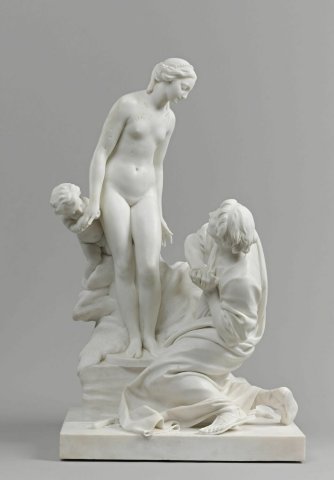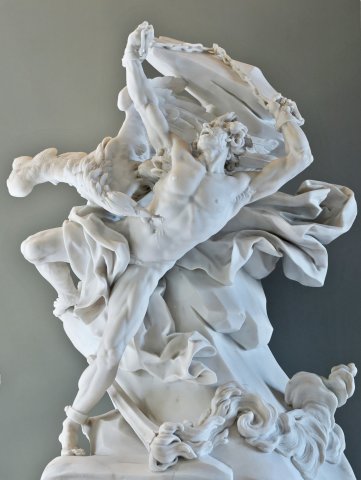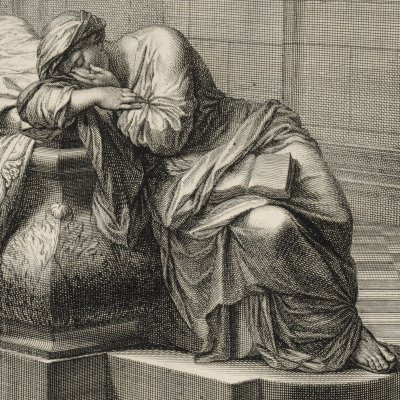[408] If I've been long on painters, on the other hand I'll be short on sculptors, and I won't have a word to say about our engravers.
Falconet
[409] O the precious thing that little group of Falconet1! That's the piece I'd have in my cabinet, if I poked my nose into having a cabinet2. Wouldn't it be better to sacrifice everything at once?... But let's leave it at that. Our enthusiasts are charm people3; they'd rather garnish their cabinets with twenty mediocre pieces than have one fine one.
The precious group I want to talk to you about, it's pretty pointless to tell you, is the Pigmalion at the feet of his animating statue. There's only this one at the Salon, and for a long time it won't have a second.
Nature and the Graces have disposed of the statue's attitude. Her arms fall limply at her sides; her eyes have just half-opened; her head is tilted a little towards the earth, or rather towards Pigmalion who is at her feet; life is detected in her by a light mouse that grazes her upper lip. How innocent she is! She's at her first thought: her heart is beginning to stir, but it won't be long before it palpitates. What soft hands! What soft flesh! No, they're not marble; press your finger against them, and the material, which has lost its hardness, will yield to your impression. How much truth there is in these ribs! what feet! how soft and delicate they are!
A little Amour has seized one of the statue's hands, which he doesn't kiss, but devours. What vivacity! What ardor! How much malice in [410]the head of this Amour! Little perfidious one, I recognize you; may I, for my happiness, never meet you again.
One knee on the ground, the other raised, hands clasped tightly together, Pigmalion stands before his work and looks at it; he seeks in his statue's eyes confirmation of the prodigy the gods have promised him. O beautiful face of his! O Falconet! how did you manage to melt surprise, joy and love into a piece of white stone? Emule4 of the gods, if they animated the statue, you renewed the miracle by animating the statuary5.
Come, let me embrace you; but fear that, guilty of Prometheus' crime6, a vulture may be waiting for you too.
The philosopher is alluding here to the penchant for jealousy from which Falconet does not appear to be exempt, and which it is crueler to feed than a vulture. Besides, if, after the great success this piece has had at the Salon, an ignoramus were allowed to raise his timid voice, I would say that the figure of Pygmalion did not strike me as beautiful in expression as the philosopher says here. It seemed to me precisely as inferior to the animating statue as the figure of Joseph is to Putiphar's wife in Deshays' painting7. Not to mention that the way this piece is composed detracts from the effect, since we can't see the statue's face and the statuary's face at the same time. But let's let the philosopher finish.
Beautiful as the figure of Pigmalion is, it could be found with talent; but one cannot imagine the head of the statue without genius.
The workmanship of the entire group is admirable. It's a single material from which the statuary has extracted three different kinds of flesh. The flesh of the statue is not the flesh of the child, nor is it the flesh of the Pigmalion.
The workmanship of the entire group is admirable.
This piece of sculpture is very perfect. However, at first glance, the neck of the statue seemed to me a little strong or its head a little weak; the people of art have confirmed my judgment. Oh, how unfortunate is the condition of an artist! How pitiless and flat8 critics are! If this group buried under the earth for a few thousand years had just been pulled out with the name Phidias in Greek, broken, mutilated in the feet, in the arms, I would look at it in admiration and silence.
Pondering this subject, I imagined another composition of it, which is here.
I leave the statue as it is, except that I ask from right to left for its action exactly the same as it is from left to right.
I keep Pigmalion's expression and character; but I place him on the left: he has glimpsed in his statue the first signs of life. [411] He was crouching at the time. He rises slowly, until he can reach the place of the heart. Lightly placing the back of his left hand on it, he looks to see if the heart is beating; yet his eyes fixed on those of his statue wait for them to half-open. Then it's no longer the statue's right hand, but the left that little Amour devours.
It seems to me that my thought is newer, rarer, more energetic than Falconet's. My figures would be even better grouped than his. They would touch. I say that Pigmalion would rise slowly; if the movements of surprise are swift and quick, they are here contained and tempered by the fear either of being mistaken, or of a thousand accidents that could cause the miracle to be missed. Pygmalion would hold his chisel in his right hand and clutch it tightly; admiration unthinkingly embraces and clutches either the thing it admires or the thing it holds.
Adam
The Prometheus that Adam tied to a rock and that a vautour tears apart9 is a piece of strength I don't feel able to judge. Who's ever seen nature in this state? Who knows if these muscles swell or contract with precision? if this is the real course of these swollen veins? Let this piece be taken to the executor of justice or to Ferein10 the anatomist, and let them pronounce. [412]
Vassé
This Woman reclining on a square plinth, weeping over an urn she covers with her drapery,and waters with her tears11 is a beautiful thing. Girardon did no better at the tomb of Cardinal de Richelieu12.
Her pain is deep; we soften as we look at her. How saddened this face is! serenity will not reappear in it for long. The whole position is simple and true, the arms well placed, the drapery beautiful, the upper part of the body gracefully bent; no awkwardness, no contortion; it seems that in her place one would not take another attitude. To properly judge the fit of a man or woman13, it's also a pretty safe rule to carry them around on canvas14.
I invited you to go and see the two paintings of the Martyrdom of Saint Gervais and saint Protais painted by Le Sueur15. In the same church, there's a tomb executed by Girardon; I believe it's that of Chancellor Séguier16. Be sure to watch a Piety tenderizing and consoling herself at the sight of a Christ she holds in her hands. Let not the passage of time, which has darkened this figure, rob you of its perfection: see its attitude, its expression, its drapery, its flesh, its feet, its hands; compare Vassé's work with this one. I know from experience that these kinds of comparisons advance infinitely in the knowledge of art.
Mignot
There's nothing this year by Mignot, the artist who exhibited at the last [413] Salon a Bacchante endormie that our statuaries unanimously placed among the antiques17.
About this Mignot, I've been revealed a maneuver of the sculptors. Do you know what they do? They take a living model's feet, hands and shoulders in plaster; the hollow of this plaster gives them back the same parts in relief, and these parts they then use in their compositions just as they came. It's a way of approaching the truth of nature without much effort; it's no longer the merit of a skilled statuary, but that of an ordinary foundryman. This ruse has been suspected on finer details superior to the longest patience and the most meticulous study of nature.
Challe
There is a Vierge by Challe18 that is noble and true; but she has flat lips, flat cheeks, in a word, what we call a flat face, which is something other than a flat face.
Alongside these pieces of sculpture there are a large number of busts; but I can never bring myself to talk to you about these mud men who have had themselves represented in marble. I exclude the Buste du Roi19, that of the Prince de Condé20, that of Madame la comtesse de Brionne21, those of La Tour22, the painter, and of the poet Piron23. This one is placed opposite the bad painting of Peter24 on which you would judge, by his mocking air and the corner of his lip turned up, that he is making an epigram; he looks similar, but he has a huge wig.
[414] Of all the engraving works there are only those by Wille that stand out25. This artist, a native of Hessen, was the Académie's first engraver.
Finish with the Portrait du roi executed in tapestry at the Manufacture des Gobelins, on the painting by Michel Vanloo26. A few hundred spectators left the Salon convinced that they had seen a piece of painting. My friend, it's scarcely less difficult to make people take wool for color than color for flesh, and I don't think there's anything in all of Europe that can compete with our Gobelins works.
That, my friend, is all I saw at the Salon. I'm writing it to you with the current of my pen. Correct, reform, lengthen, shorten, I approve of everything you do. I may have been mistaken in my judgments either through lack of knowledge or lack of taste, but I protest that I know none of the artists I have spoken of other than through their works, and that there is not a word in these sheets that hatred or flattery have dictated. I felt, and I said what I felt. The only partiality I haven't guaranteed myself, because frankly I don't know how one would guarantee oneself, is that which one quite naturally has for certain subjects or for certain doings.
You will no doubt have noticed as I did that, although this year's Salon offered many fine productions, there were a multitude of mediocre and wretched ones, and that, all things considered, it was less rich than the previous one; that those who were good remained good; that, with the exception of Lagrenée, those who were mediocre are still mediocre, and that the bad ones are no better than before.
And above all, remember that it's for my friend and not for the public that I write. Yes, I'd rather lose a finger than upset honest people who have exhausted themselves with fatigue to please us. Because [415]a painting has not won our admiration, must it become the artist's shame and torment? If it is good to have severity for the work, it is even better to spare the fortune and happiness of the worker. Whether a piece of canvas is smeared or a cube of marble is spoiled, what is this loss compared to the bitter sigh that escapes from the heart of the afflicted man? These are faults that never merit public correction. Let us reserve our whip for the wicked, the dangerous fools, the ungrateful, the hypocrites, the concussionists, the tyrants, the fanatics and the other scourges of the human race; but may our love for the arts and letters and for those who cultivate them be as true and as unalterable as our friendship.
Notes
The Pygmalion and Galatée. See the Louvre version #010198 and the Baltimore version #000744, as well as the Sèvre cookie reduction, #021186. The description of the sculptures in the Salon de 1763 does not follow the order of the libretto. Only at the end of the text will Diderot mention Lemoyne's Portrait du roi, which as Recteur's assistant was presented at the head of the "Sculptures" section.
To have a collection of works of art, with which to transform one's apartment into an exhibition cabinet. "Cabinet, also means a room in an apartment & a secluded place in ordinary houses, where one studies, where one sequesters oneself from the rest of the world, & where one closes what one has most precious.Musæum. [...] Cabinet of paintings, books, &c. Is a cabinet where one keeps Paintings, Books, &c." (Trévoux)
" Breloque. Some people say Breluque, s. f. Bagatelle, or small curiosity of little value. Frivola. The curious who go to see cabinets where there are no rare & exquisite pieces, say to despise them, that there are only breloques. Du Cange derives this word from belluga, which is a kind of aroma, or small apple spoken of in the life of S. Colomban, which serves as a comparison for all things whose smallness, unimportance, we wish to mark."
Rival, competitor.
By animating Pygmalion, by making him look alive, Falconet performed the same miracle as Venus, by animating Galatea, by giving life to the statue.
Prometheus, by giving fire to men, encroached on Zeus' prerogatives, and was cruelly punished. Falconet committed a similar sacrilege, and will be punished by his bad temper. See Grimm. At the Salon of 1775, Boizot exhibited a Prométhée intended as a counterpart to Falconet's Pygmalion . This Prométhée will be copied by Staggi in Saint-Petersburg (#021187), along with a copy of Falconet's Pygmalion (#007966). Did Diderot inspire this pairing?
See #009632.
In the preamble to the Salon of 1765, Diderot wrote: "Taste is deaf to prayer. What Malherbe said of death, I would almost say of criticism; everything is subject to its law." (DPV XIV 25)
See #011359.
Antoine Ferrein (1696-1769), physician and anatomist, trained in Montpellier. Ranked first for a chair of anatomy in Montpellier, he was not appointed by the king, and left for Paris, where he became professor of surgery in 1742. Ferrein did not contribute directly to the Encyclopédie, but he is cited there nine times, in the article Anatomy and, in particular, for his work on the voice (Consonant, Declamation of the Ancients, Eunuch, Spiral Spring, Voice, Voice of Quadrupeds).
"et qu'elle arrose de ses pleurs" is deleted in the Léningrad and Vandeul copies, to match the title given by the libretto. Instead, the libretto states, "This Figure, executed in marble 4 feet 6 inches in proportion, is part of the Tomb of Madame la Princesse de Galitzin."
See #021189.
To see if the folds of their clothes fall properly.
To see how the pleats would fall in paint.
Diderot has already mentioned them in connection with Deshays' Résurrection de Lazare (DPV XIII 377). See #001005 and #021191.
There is no record of a tomb for Chancellor Séguier at the church of Saint-Gervais-saint-Protais in Paris: he is buried at the church of Carmel in Pontoise. See, however, the mausoleum erected by Le Brun on the occasion of his funeral, in the church of the Oratoire in the rue Saint-Honoré, whose engraving by Sébastien Leclerc was widespread (#021192), and with which Diderot may have confused Michel Le Tellier's cenotaph, in the chapelle de Brégy to the south of the chapelle de la Vierge in the church of Saint-Gervais-saint-Protais. The figure on the right of this cenotaph is a Piété holding a cross in her hands. It is not by Girardon but by Mazeline, who worked for Girardon. See #021193.
See #000736.
This Virgin is lost. A Vierge de l'Immaculée conception (thus without baby Jesus) dated 1764 and executed in marble after a modello exhibited at the Salon of 1759 entered the Louvre collections in 2011. See #021194.
The bust of Louis XV exhibited by Lemoyne in 1763 has not been identified. See the 1749 bust at Versailles (#021195) and the 1757 bust at the Metropolitan Museum (#021196).
By Caffieri, see #021198.
By Lemoyne, see #021199.
By Lemoyne, see #021200.
By Caffieri, see #010296.
See #000981.
Two engravings were on display, La Liseuse (#021201) and Le jeune joueur d'instruments (#021202).
See #021203.
Les Salons de Diderot (édition)
Archive mise à jour depuis 2023
Les Salons de Diderot (édition)
Salon de 1763
Préambule du Salon de 1763
Louis-Michel Vanloo (Salon de 1763)
Deshays (Salon de 1763)
Greuze (Salon de 1763)
Sculptures et gravures (Falconet, Salon de 1763)
Salon de 1765
La Chaste Suzanne (Carle Vanloo, Salon de 1765)
Boucher (Salon de 1765)
La Justice de Trajan (Hallé, Salon de 1765)
Chardin (Salon de 1765)
La jeune fille qui pleure son oiseau mort (Greuze, Salon de 1765)
La Descente de Guillaume le Conquérant en Angleterre (Lépicié, Salon de 1765)
L'antre de Platon (Fragonard, Salon de 1765)
Sculpture (Salon de 1765)






